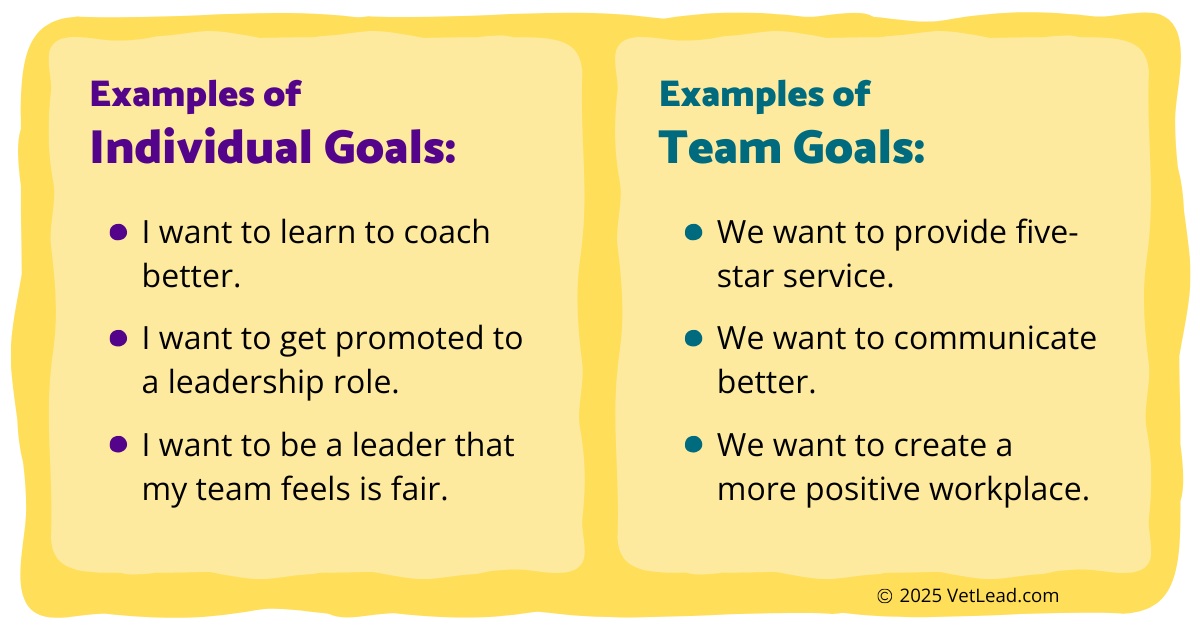Most veterinary practices are built on good intentions, routine, and hard work. But if you walk into a practice where people don’t know what they’re aiming for, you can feel the difference right away. Teams without clear goals end up surviving each day, instead of building the kind of workplace everyone wants to be part of.
As a leader, your ability to set and share meaningful goals doesn’t just improve performance. It creates a culture of engagement, accountability, and progress. When you learn to set goals well, you give your team a reason to care about the future, not just the next shift.
Let’s explore what it looks like to set the right goals for your practice, your team, and yourself.
Why Goals Matter for You and Your Veterinary Team
You might be tempted to think of goals as just another leadership buzzword. But goals have real power in veterinary practices, for several reasons:
If you want your practice to be a place where people show up motivated and leave each day feeling like they accomplished something, you need clear goals.
Set Individual and Team Direction in Your Practice
Great leaders help both themselves and their teams set goals that matter. Both are important for building a culture where everyone is growing.
The most effective leaders set them for themselves and their teams. Here are some real examples of individual and team objectives that can help drive progress, engagement, and a stronger culture in your veterinary practice.

Notice that these aren’t just about getting through tasks. They’re about creating a better future for yourself or your team. Individual goals drive personal growth, while team goals unite everyone around a shared purpose.
What Makes a Goal Successful?
Not all goals are created equal. They will only help you or your team move forward if they are compelling and aligned with real success.
Two Simple Criteria for Successful Goals:
A meaningful goal needs to be compelling, something you or your team genuinely care about. If a goal doesn’t matter to you, even the most specific or measurable plan won’t lead to real progress. Along with that, it should be aligned with true success, moving you closer to the kind of impact or culture you want to create in your practice. Goals set purely for comfort or out of habit rarely produce growth. The best goals inspire you to reach for something better, not just maintain the status quo.
Many leaders have been taught to use the SMART goal system: Specific, Measurable, Attainable, Relevant, and Time-based. While that approach helped people start thinking about goals, it leaves out the most important part: wanting the goal and connecting it to real outcomes. You can have a perfectly written SMART goal that you have no interest in achieving, or that doesn’t actually lead to a better practice.
The best goals come from asking the right questions:
If you can answer those questions honestly, you’re on the right track.
How Habits Move You Toward Your Goals
Even the best goal means little without action. Progress is built on small, consistent habits. Setting the right goal is a great first step. Real progress comes from small, consistent actions. The best habits are:
Start with one simple action and focus on doing it consistently. Progress is built on repetition, not big leaps.
Steps to Progress in Your Practice
Ready to set goals that actually move your practice forward? Here’s how to get started:
- 1Start with both individual and team goals. As a leader, ask yourself what you want to get better at, and invite your team to do the same. For your team, ask what would make your practice a better place to work and a better place for clients.
- 2Make sure every one is compelling and aligned with success. If a goal doesn’t matter to you or your team, or if it doesn’t lead to a better practice, set a different one.
- 3Focus on small, repeatable actions. Once you have your goal, look for the smallest habit you can start today that moves you in that direction. Don’t wait for perfection, just start.
- 4Track and celebrate consistency. Progress is about repetition. Celebrate when you or your team stick with new habits, even if the end result is still ahead.
Lead Your Veterinary Practice with Purpose
Practices that set clear, meaningful goals outperform those that just try to get through the day. When you and your team know what you’re working toward, you become more engaged, more accountable, and more successful.
If you want to build a practice people are excited to show up for, start by setting one meaningful goal for yourself or your team this week. Then, focus on the small actions that will move you closer to it. Over time, those actions will become habits, and your goals will start to feel less like dreams and more like your daily reality.
You get to decide what kind of future your practice will have. The first step is choosing a goal that matters. What’s one goal you’ll set for yourself or your team this week?
What do you think? Other veterinary pros want to hear from you! Share your experience in the comments below.